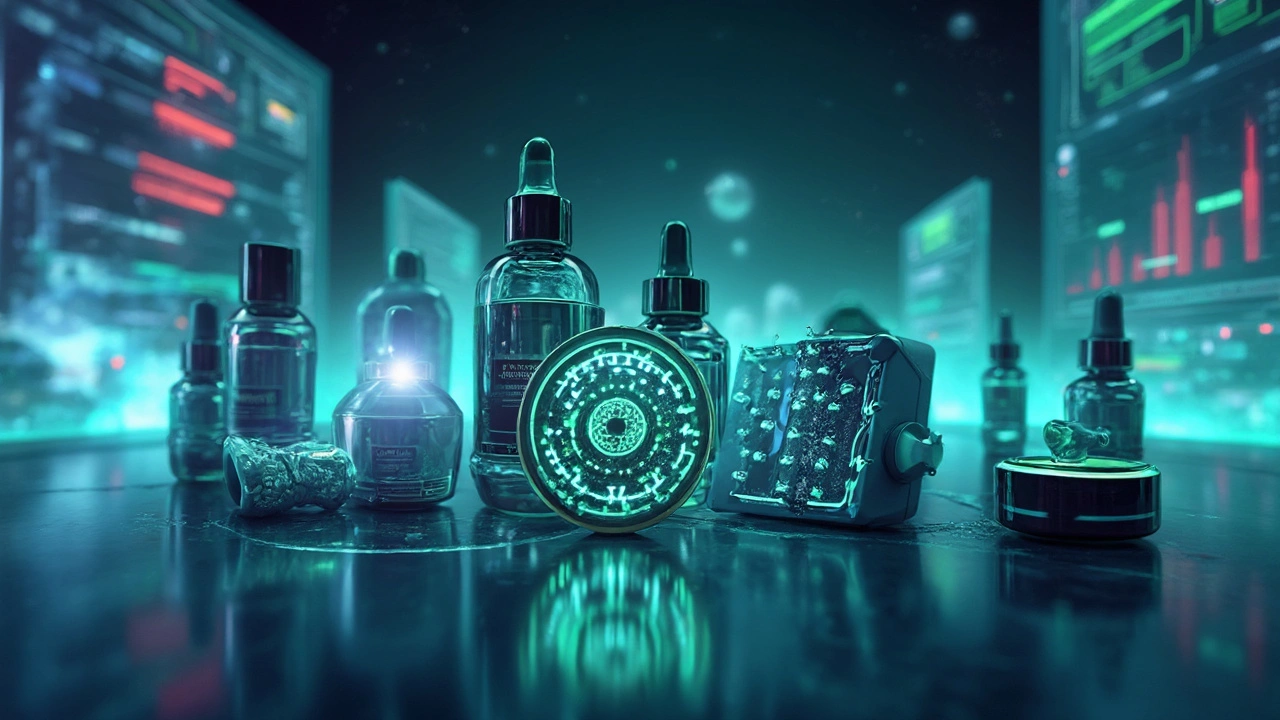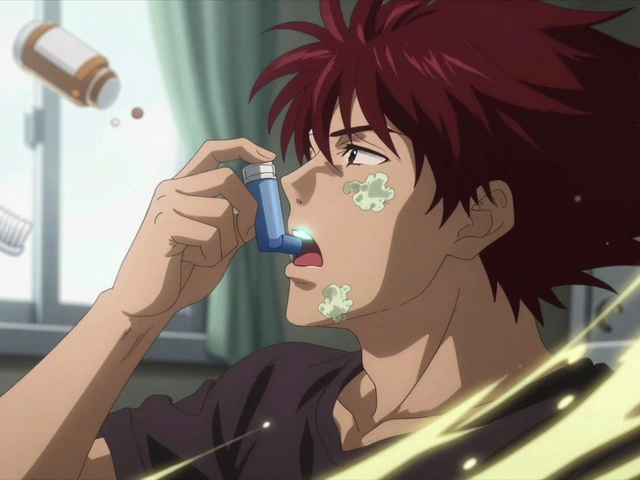In 2025, the quest for hair loss solutions has never been more varied and promising. While Finasteride remains a well-known treatment, it's not everyone's cup of tea due to potential side effects. If you're looking for other options, you’re in luck—there are many promising alternatives to explore.
One option that's gaining a lot of traction is using Derma Stamps, also known as microneedling. This method involves using tiny needles to create micro-injuries in your scalp, which might sound intense, but it’s actually quite safe when done right. The main aim here is to boost the absorption of topical treatments, like Minoxidil. If you’re already using something like that but not seeing the desired effects, microneedling might just be the hack you need.
This approach has its upsides and downsides, of course. On the plus side, it can seriously amp up the efficacy of what you’re already putting on your scalp, while staying relatively non-invasive and requiring minimal downtime. The downside? Well, it does require a bit of skill to do it properly, and you might have to put up with a bit of redness afterwards. Plus, while the results can be quite promising in the short run, they might not last forever.
- Derma Stamps (Microneedling)
- Minoxidil
- Low-Level Laser Therapy
- Saw Palmetto
- Pumpkin Seed Oil
- Biotin Supplements
- Ketoconazole Shampoo
- PRP Therapy
- Hair Transplant
- Rosemary Oil
- Conclusion
Derma Stamps (Microneedling)
If you're navigating the Finasteride alternatives scene in 2025, Derma Stamps or microneedling might be on your radar. This approach is all about boosting the efficacy of products you might already be using, like Minoxidil. By creating tiny, controlled injuries on your scalp, it enhances absorption, promising better results.
Let’s break it down a bit more. Imagine your scalp is a fortress, keeping out invaders, including helpful treatments. Microneedling opens small gates – these micro-injuries – allowing your hair growth methods to penetrate effectively and do their job. It's a bit like giving your treatments VIP access.
Pros of Derma Stamps
- Can significantly improve the benefits of topical treatments, boosting their effectiveness.
- A minimally invasive procedure with a quick recovery time.
- The process can be done in the comfort of your home, making it accessible and convenient.
Cons of Derma Stamps
- Requires a bit of know-how to use the tools safely and effectively.
- May cause temporary redness or irritation of the scalp right after treatment.
- Results might not be long-lasting, requiring ongoing use for sustained benefits.
For those considering this route, it’s worth noting that while microneedling is generally safe, it’s important to start slow. Read up or watch tutorials before diving into your first session. Using a bit too much pressure can cause unwanted side effects, so gentleness is key. And remember, patience pays off; although the effects can be quick, don’t expect miracles overnight.
Minoxidil
When it comes to hair loss treatments, Minoxidil is probably one of the most talked-about alternatives. Originally created to treat high blood pressure, its surprising side effect of promoting hair growth made it an unexpected hero in the fight against hair loss. Most people use it as a topical treatment—typically in the form of foams or solutions you apply directly to the scalp.
Pros
- It is FDA-approved for promoting hair growth, which gives a sense of security and trust.
- Many find it to be effective, with users often seeing results after about four to six months of consistent use.
- Non-prescription availability makes it easy to purchase online or from local stores.
Cons
- Consistency is key; if you stop using a Minoxidil solution, gained hair may be lost.
- Some users experience irritation or an allergic reaction on the scalp, which can be a downside.
- While it's great for the crown of your head, it's not as effective for receding hairlines.
Studies showcase that about 40% of men notice hair regrowth with regular use, making Minoxidil a popular choice. Keep in mind, though, persistence and regularity are crucial in seeing those desired results.
Low-Level Laser Therapy
Low-Level Laser Therapy (LLLT) is a pretty cool option if you're up against hair loss and not keen on the typical meds like Finasteride. This technique uses laser devices to stimulate hair growth, and it's more popular than ever in 2025.
Did you know that LLLT works by using specific wavelengths of light to penetrate your scalp and invigorate your hair follicles? It's like giving your scalp a wake-up call, encouraging thicker and stronger hair growth. This process is non-invasive and usually painless, which is a big plus if needles aren’t your thing.
Pros
- Pain-free, non-invasive option.
- Can improve hair density and strength.
- Minimal to no downtime required.
Cons
- You'll need to commit to regular sessions.
- Results can take time to show up, sometimes months.
- Professional treatments can get pricey.
If you're considering LLLT, it’s handy to know that devices are available for home use, though professional treatments might yield better results depending on your particular needs and budget. In 2023, for instance, a study from a renowned dermatology group found that regular LLLT treatments led to a 37% increase in hair density for many users after six months.
By keeping this consistent commitment, you might just find the solution you've been searching for without the long list of side effects some drugs present. Whether it becomes your main method or part of a broader strategy, LLLT offers a promising route for folks dealing with hair loss.
Saw Palmetto
Looking for a natural alternative to Finasteride? Saw Palmetto might just be the herbal hero you need. Extracted from the fruit of a small palm native to the southeastern US, this plant has been linked to hair growth for quite some time.
The main draw of Saw Palmetto is its ability to potentially reduce DHT levels in the body. DHT is the hormone often responsible for hair thinning in both men and women. According to a study published in the Journal of Alternative and Complementary Medicine, "Saw Palmetto has shown promise in treating androgenetic alopecia (AGA) with some successes comparable to those achieved by Finasteride."
Saw Palmetto has shown promise in treating androgenetic alopecia (AGA) with some successes comparable to those achieved by Finasteride.
Pros:
- Natural ingredient and widely accessible.
- Potentially fewer side effects compared to Finasteride.
- Can be used in conjunction with other treatments.
Cons:
- Results may vary dramatically from person to person.
- Not FDA-approved specifically for hair loss.
- Research is still ongoing, and long-term effects are unclear.
Although some folks swear by its efficacy, remember that it's not a guaranteed fix for everyone. But if you're exploring your options, especially if you'd prefer a more natural route, it's definitely worth a shot.
Pumpkin Seed Oil
When it comes to natural hair loss solutions, Pumpkin Seed Oil is stirring up quite the buzz. Known for being rich in nutrients, this oil might just become your next haircare go-to. Packed with phytosterols, it's believed to inhibit the enzyme responsible for hair loss, similar to how some pharmaceutical treatments work—yet without the synthetic touch.
If you're wondering whether it's worth incorporating into your routine, consider this: a study published in the Evidence-Based Complementary and Alternative Medicine Journal noted a significant increase in hair count for participants using pumpkin seed oil over six months. Hair growth went up by a whopping 40% compared to those on a placebo.
The researchers concluded, "Pumpkin seed oil could indeed offer an alternative method to encourage hair growth, boasting a favorable safety profile."
Pros
- Naturally derived with minimal processing.
- Rich in nutrients like zinc and antioxidants.
- May improve hair thickness and density.
Cons
- Results can take time and vary by individual.
- Usually more effective when combined with other treatments.
- Potential for scalp oiliness if not washed out properly.
To apply, you simply massage a few drops directly onto your scalp or mix it with a carrier oil if you're sensitive. Not too bad, right? For those more inclined to go the route of supplementation, you can also find it in capsule form. It’s all about finding what blends seamlessly into your daily routine. Whatever way you flip it, pumpkin seed oil is anything but basic—it’s a natural option that might just work wonders for those keen on keeping things au naturel.

Biotin Supplements
When it comes to tackling hair loss in 2025, biotin has garnered attention as an accessible and natural alternative. It’s a type of B vitamin that your body loves, especially when it comes to keeping hair, skin, and nails in tip-top shape.
Biotin's claim to fame is its ability to support the growth and strength of healthy hair by boosting keratin production, which is the protein that hair is made of. While its effectiveness can vary, some folks swear by it.
How Does Biotin Work?
Biotin aids in the metabolism of amino acids and fats, which are essential for the production of keratin. This can potentially lead to stronger hair and reduced shedding. It’s like giving your scalp a supportive nutrient nudge.
“Biotin can be a beneficial supplement for individuals experiencing hair thinning when accompanied by a balanced diet,” says Dr. Elisa Hartmann, dermatologist.Dr. Hartmann insists on using biotin as a bridge, rather than a complete solution—pairing it with a healthy lifestyle can do wonders.
Benefits of Biotin Supplements
- Supports Hair Health: Biotin contributes to thicker and more resilient hair.
- Easy to Incorporate: Available in various forms like tablets, capsules, and gummies for simple integration into your routine.
- Generally Safe: Most people can use biotin without concerns of major side effects.
Potential Downsides
- Varying Results: Not everyone experiences significant hair growth from biotin use.
- Overdose Risks: Excessive biotin can interfere with medical lab tests.
- Supplement Quality: Not all products are created equally, so quality may differ.
If you're considering biotin as part of your hair care routine, make sure you're sticking to the recommended daily dose. It’s always a good idea to chat with a healthcare provider before making significant changes, especially to avoid any unintended interactions or surprises.
Ketoconazole Shampoo
When it comes to fighting hair loss and dandruff, Ketoconazole Shampoo is a real contender. Originally an antifungal treatment, it’s been discovered that this shampoo can do more than just clear pesky flakes. There's a growing belief that it might help with hair loss too, and that's got people talking.
Now, why does an antifungal shampoo matter for hair loss? Well, it’s believed to have anti-inflammatory properties. These properties may help reduce the inflammation that often accompanies hair thinning. Plus, it might help manage the natural oils on the scalp which can sometimes get out of hand.
"Studies have shown that Ketoconazole can be an effective adjunct therapy for androgenic alopecia," says Dr. Sarah Green from the Dermatological Institute.
Using Ketoconazole Shampoo is pretty straightforward. You generally use it a couple of times a week, letting it sit on your scalp for a few minutes before rinsing it out. It's crucial not to overdo it, though, as overuse may lead to dryness.
Pros
- Easy to incorporate into your routine
- Might help with scalp inflammation
- Can also tackle dandruff
Cons
- Potential for scalp dryness
- Effects may vary from person to person
- Not a standalone solution for hair loss
According to a survey conducted in 2024, approximately 65% of users reported seeing an improvement in their hair condition when they incorporated Ketoconazole Shampoo into their routine.
It’s essential to remember that while this shampoo can be a useful part of a hair care regimen, it's typically most effective when used alongside other treatments. Always chat with your healthcare provider to see if it fits your needs.
PRP Therapy
PRP Therapy, or Platelet-Rich Plasma Therapy, is making waves as a hair loss solution in 2025. It's not exactly new, but its application in treating hair thinning is becoming increasingly popular. So, what’s the deal with PRP? Essentially, this therapy uses your own blood, which is spun in a centrifuge to concentrate the platelets. These platelet-rich plasma cells are then injected back into your scalp at the hair follicle level. The idea is that PRP can promote hair growth by encouraging cell rejuvenation and boosting circulation in the scalp area.
Pros of PRP Therapy
- Uses your own body's resources
- Minimally invasive compared to surgical options
- No major side effects for most people
Cons of PRP Therapy
- Requires multiple sessions over time
- Costs can add up—it's not the cheapest option out there
- Results can vary from person to person
Now, is PRP Therapy worth considering as an alternative to Finasteride? Many swear by its effectiveness in enhancing hair density. However, you need to be patient and consistent with this treatment. One session won’t cut it—you’re looking at a series of treatments over several months to really see some changes. Keep in mind that the cost can be a factor as it’s not always covered by insurance.
If you’re someone who prefers a more natural approach, this might be an appealing route. Just remember that like many things in the hair-loss world, what works for someone else might not work for you. It's always a good idea to have a chat with a dermatologist to see if PRP Therapy aligns with your hair goals.
| Sessions Required | Typical Cost per Session |
|---|---|
| 3-6 Sessions | $400 - $700 |
Hair Transplant
When it comes to tackling hair loss, a hair transplant is probably one of the first things that come to mind. It's a tried-and-true method for those with thinning hair who want a more permanent solution.
What It Involves
The procedure basically consists of moving hair follicles from one part of your body—usually the back of the head, where hair tends to be thicker—to areas where the hair is thinning. This process is known as Follicular Unit Transplantation (FUT) or Follicular Unit Extraction (FUE), depending on the technique used.
- FUT: This technique involves removing a strip of scalp from the back of the head and separating it into smaller grafts.
- FUE: This method involves individually extracting hair follicles from the donor area and then transplanting them to the thinning area.
Why Consider It?
The main appeal of hair transplants is their potential for reliable and long-lasting results. If done properly, it can significantly improve the density of your hair, and the transplanted hair can last a lifetime.
What's the Catch?
On the downside, hair transplants can be pricey and sometimes require multiple sessions to achieve desired results. There’s also a recovery period to consider, which can involve some discomfort and swelling.
Cost and Success Rate
The average cost varies widely depending on location and method but expect to pay anywhere from $4,000 to $15,000 per session in 2025. Success rates are quite high, often above 90%, when performed by experienced professionals.
| Technique | Recovery Time | Average Cost (2025) |
|---|---|---|
| FUT | 2-4 weeks | $5,000 - $10,000 |
| FUE | 1-2 weeks | $7,000 - $15,000 |
If a hair transplant seems like a potential solution, it’s crucial to do some homework. Consultations with multiple surgeons can give you a better idea of what to expect in terms of both results and expenses.
Rosemary Oil
Looking for a natural way to tackle hair loss? Rosemary oil might just be what you need. This essential oil has been making waves in the hair care world, thanks to its potential in promoting hair growth and improving scalp health.
What's cool about rosemary oil is its ability to stimulate circulation when applied to the scalp. This increased blood flow can lead to better nutrient delivery to hair follicles, which may encourage healthy hair growth. Some small studies even suggest that rosemary oil can be as effective as minoxidil, especially for folks dealing with androgenetic alopecia, a common form of hair loss.
Pros
- Natural and easily accessible.
- Boosts circulation and might promote hair growth.
- Can improve overall scalp health.
Cons
- Results may take a few months to appear.
- Can cause irritation if not diluted properly in a carrier oil.
- Less researched compared to some other treatments.
When using rosemary oil, always dilute it with a carrier oil like coconut or jojoba to prevent any irritation. Apply it to your scalp a few times a week and massage for a few minutes. It's a simple routine, but consistency is key to seeing results. So, if you're aiming for a natural route in your hair growth journey, rosemary oil might be worth a try!

Conclusion
As we look at the hair loss landscape in 2025, we've got a lot more options beyond just reaching for Finasteride. Each alternative has its own unique benefits and some drawbacks, which means there’s probably something that fits your needs.
Derma Stamps (Microneedling) have made quite a mark. They can enhance the effects of treatments you're already using, like Minoxidil, with just a bit of extra effort. Remember though, they require precise handling, so it's best to get the technique down or consult a pro.
Then there’s Low-Level Laser Therapy, which sounds like sci-fi but is totally legit. It can promote hair growth by increasing blood flow to your follicles. Plus, it's non-invasive, making it a pretty comfy option.
Natural routes like Saw Palmetto and Pumpkin Seed Oil are appreciated for their gentleness and ease of access. They’re not magic bullets but can be useful parts of a broader hair care routine.
Biotin Supplements have been around for a while and still hold their ground for those who want an easy add-on to their daily regimen. And of course, Ketoconazole Shampoo for its practical use in clearing up scalp conditions while supporting hair growth.
Let’s not forget the more intensive methods like PRP Therapy and Hair Transplant for those looking for serious results, albeit with a bit more commitment, time, and cash.
Last but not least, Rosemary Oil sneaks in for an aromatic, natural boost, often used as a supplement to other treatments.
Quick Comparison
| Alternative | Pros | Cons |
|---|---|---|
| Microneedling | Enhances treatment absorption, minimal downtime | Requires skill, temporary redness |
| Low-Level Laser Therapy | Non-invasive, increases blood flow | Time-consuming, expensive |
| Saw Palmetto | Easy to use, natural | Slow results |
Deciding on a hair loss treatment is personal, and it's all about figuring out what best fits your lifestyle and goals. Exploring these Finasteride alternatives can open up new possibilities for your hair care journey. Whether you stick with the natural path, try high-tech options, or mix and match, it’s all about finding what helps you best.






Suzanne Podany
July 19, 2025 AT 03:03This article provides a wonderful overview of potential alternatives to Finasteride, which I think is crucial given the varying reactions and side effects some people experience with it. Microneedling with Derma Stamps sounds intriguing, especially for improving topical absorption. It’s great to see innovations that combine technology and natural methods for hair care.
But I wonder about the accessibility and cost-effectiveness of these methods? Not everyone can easily afford frequent microneedling sessions or specialized devices. It would be helpful if the article also discussed options that are both effective and budget-friendly.
Additionally, understanding each alternative’s suitability for different hair types and conditions could help readers make a more personalized choice. Any insights on how these alternatives perform across diverse populations?
Nina Vera
July 19, 2025 AT 15:00Okay, can we talk about how people are just *fed up* with Finasteride and all its drama — the side effects, the uncertainty, the endless warnings? Seriously, this article might just be a beacon of hope for many out there desperately searching for something that won’t mess them up.
But honestly, these newer alternatives, like Microneedling, sound way more time-consuming and kind of intimidating? I’m picturing poking my scalp with tiny needles and thinking, "Is this really gonna fix my hair or just make me look like a pin cushion?"
Still, I’m totally curious and ready to jump in if the results are as good as they say. Anyone here tried any of these? What are your horror stories or success tales?
Christopher Stanford
July 20, 2025 AT 06:00Lol kno one has perfect hair luck but way too many hype ideas are just distractions. The microneedling sounds meh, just another gimmick to put $$$ in the pockets, idk tho. Finasteride has been draggin a bad rep but it works for many. The alternatives better come with proof not just fluff.
Also, the spelling and grammar in some online hair loss stuff is all over the place. That kinda stuff makes me suspicious of legit science. Anyone got links to legit studies backing any of these methods?
Steve Ellis
July 20, 2025 AT 19:37I really appreciate the exploration of alternatives here — Finasteride isn’t for everyone, and having options is empowering. Microneedling as a way to boost topical absorption makes scientific sense, as micro-wounds can enhance skin permeability.
From a practical standpoint, I’d advise anyone interested to consult a dermatologist to assess individual needs before diving in. Hair growth is complex, and sometimes a combination of treatments yields the best results.
Has anyone combined microneedling with natural topical treatments? How’s that working out?
Harold Godínez
July 21, 2025 AT 13:07Great read overall! I'm always on the lookout for credible alternatives, especially since Finasteride can be a hassle with its daily regimen and side-effect profile.
I’d love to see more details on how these alternatives affect hair follicle biology differently. For example, does microneedling stimulate dermal papilla cells in a way Finasteride does not? Or do these methods just offer a different route to the same end?
Any scientific consensus or expert opinions would bolster confidence in trying new methods.
Sunil Kamle
July 22, 2025 AT 04:57One must weigh the fascade of options available in 2025 very carefully, since many alternatives promise the moon while delivering shadows. Microneedling, while innovative, remains a procedure requiring consistency and proper technique to be effective; not some magic wand to wave at hair loss.
Moreover, it is imperative to distinguish marketing hype from scientifically validated treatment. Without rigorous peer-reviewed backing, these alternatives might lead individuals astray from treatments with proven efficacy.
In my estimation, a balanced approach blending cautious optimism with critical evaluation is the only credible path forward.
Michael Weber
July 22, 2025 AT 18:17The existential weight of hair loss treatments cannot be overstated. Finasteride, the supposed panacea, often brings more psychological turmoil with it than relief. These alternatives, like microneedling, are almost poetic acts of rebellion against the cellular decay and inevitable decline.
Yet, we must confront the truth that no topical or procedural plea can fully resist the entropy of aging follicles. The ritual of hair restoration reflects a deeper human desire to preserve identity and self-worth.
Have any of you considered the emotional landscape surrounding these choices, beyond just efficacy?
Blake Marshall
July 23, 2025 AT 13:10Everyone keeps going on about microneedling but aren't there other solutions that maybe don't require wounding your scalp on the regular? Personally, I've read some good things about low-level laser therapy. Also, some natural oils have shown promise if you use them consistently.
Not saying these will work miracles, but if you’re someone nervous about chemicals or side effects from meds like Finasteride, maybe these could be worth a shot without the scary needles.
Anyone here experimented with those instead?
Shana Shapiro '19
July 24, 2025 AT 05:00This topic hits close to home for me. I’ve tried Finasteride and had some awful side effects that no one warned me about. Reading about these alternatives feels like a lifeline.
My biggest fear is falling into scams or unproven methods that sound good online but don't work in reality. I agree that personalizing hair treatment based on your unique scalp condition is crucial, but accessing reliable info is tough.
Does anyone know any dermatologists or clinics specializing in these newer treatments? Would be great to hear recommendations.
Jillian Bell
July 24, 2025 AT 22:47I can’t help but be suspicious of the whole Finasteride replacement hype. Big Pharma and related industries love to sell you the ‘next best thing’ while quietly hiding the real consequences. Isn’t it odd how each year some new method pops up promising hair miracles right after patents expire?
Microneedling sounds almost too good to be true, like an engineered distraction while the actual systemic causes of hair loss get ignored by mainstream. Are we seriously just blind to the bigger picture here?
I urge everyone to dig deeper and question the narrative pushed by these articles and companies.
Lindsey Bollig
July 25, 2025 AT 18:30This article feels like an important step toward empowering people dealing with hair loss. Finasteride’s side effects can be daunting, so having options is essential. From personal experience, microneedling combined with topical minoxidil showed visible improvement when done consistently.
My advice: be patient and consistent, and consult professionals to tailor treatment to your scalp type and condition. Not every method suits everyone, so trying alternatives thoughtfully is key.
Has anyone else tried combining microneedling with natural supplements or dietary changes? It seems like holistic care really impacts outcomes.